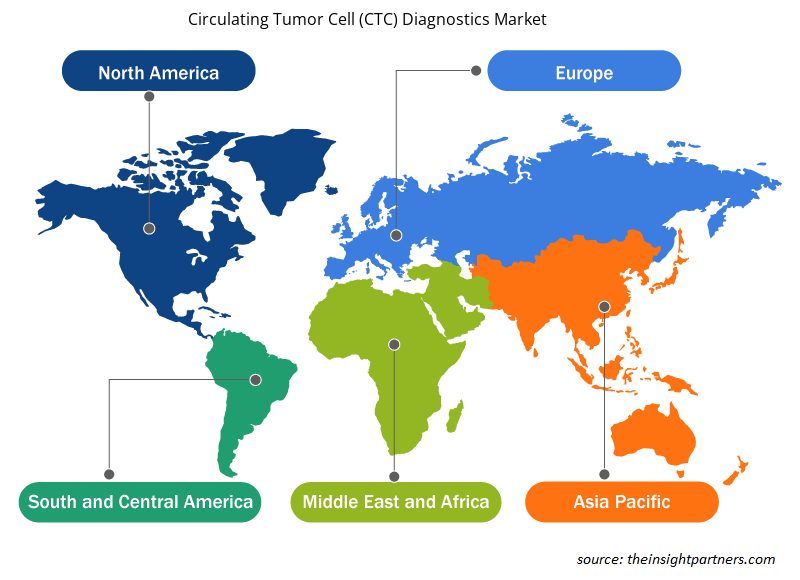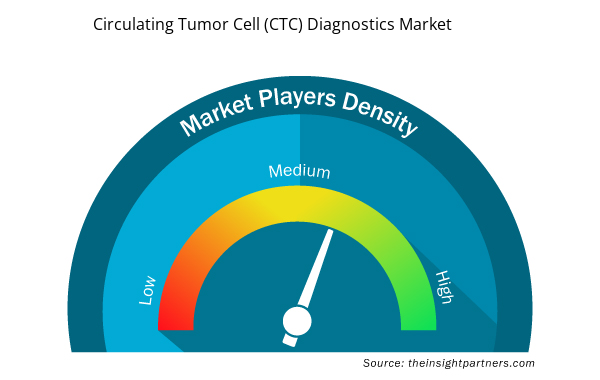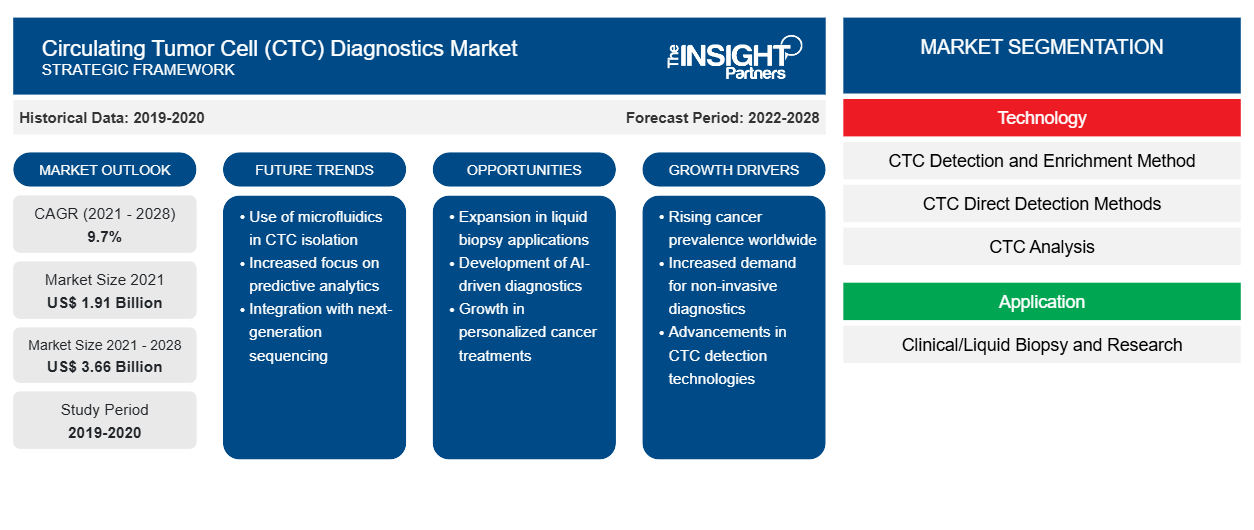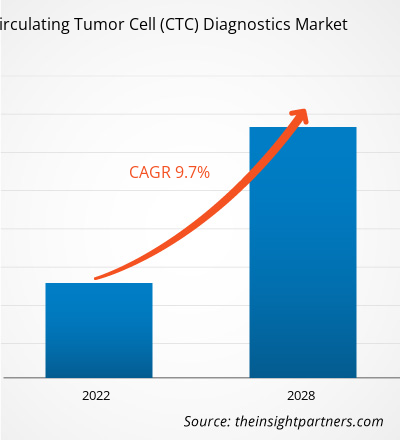Se proyecta que el mercado de diagnóstico de células tumorales circulantes (CTC) alcance los US$ 3.656,38 millones para 2028 desde los US$ 1.909,41 millones en 2021; se estima que crecerá a una CAGR del 9,7% entre 2021 y 2028.
Las células tumorales circulantes (CTC) tienen un enorme potencial para diagnosticar y tratar el cáncer. Se han desarrollado muchas técnicas que se encuentran en constante mejora para mejorar su eficacia en la detección, aislamiento, enriquecimiento y análisis de las CTC. El método más utilizado para la detección y el aislamiento de las CTC es la detección basada en el sistema inmunitario, mediante la cual los anticuerpos se unen selectivamente a los antígenos de la superficie celular. Las células tumorales expresan marcadores de superficie celular diferentes a los de las células sanguíneas y se separan de las células circulantes. Las CTC ayudan a detectar subgrupos menores de células presentes en el tejido primario, que podrían eventualmente causar resistencia al tratamiento o recaída de la enfermedad. Por lo tanto, la detección y caracterización de las CTC puede convertirse en un paso inevitable en el tratamiento de las neoplasias malignas de tumores sólidos.
Personalice este informe según sus necesidades
Obtendrá personalización en cualquier informe, sin cargo, incluidas partes de este informe o análisis a nivel de país, paquete de datos de Excel, así como también grandes ofertas y descuentos para empresas emergentes y universidades.
- Obtenga las principales tendencias clave del mercado de este informe.Esta muestra GRATUITA incluirá análisis de datos, desde tendencias del mercado hasta estimaciones y pronósticos.
El mercado de diagnóstico de células tumorales circulantes (CTC) está segmentado en función de la tecnología, la aplicación, el usuario final y la geografía. El mercado, por geografía, está ampliamente segmentado en América del Norte, Europa, Asia Pacífico, Oriente Medio y África, y América del Sur y Central. El informe ofrece información y un análisis profundo del mercado, haciendo hincapié en parámetros como las tendencias del mercado, los avances tecnológicos y la dinámica del mercado, junto con el análisis del panorama competitivo de los principales actores del mercado a nivel mundial.
Perspectivas del mercado
La creciente demanda de procedimientos de diagnóstico mínimamente invasivos impulsará el crecimiento del mercado de diagnóstico de células tumorales circulantes (CTC) durante el período de pronóstico
Existe una creciente preferencia entre los pacientes por procedimientos mínimamente invasivos o no invasivos con fines de diagnóstico. La detección temprana del cáncer, la detección de mutaciones, el seguimiento del tumor durante el tratamiento y el seguimiento de la recurrencia son posibles mediante el diagnóstico de células tumorales circulantes, que utiliza un método no invasivo. Los investigadores pueden rastrear todos los cambios epigenéticos y genéticos en tumores sólidos utilizando muestras de sangre con células tumorales circulantes. Los pacientes corren un menor riesgo con estas pruebas y los médicos pueden realizarlas fácilmente varias veces. Los pacientes prefieren los procedimientos mínimamente invasivos porque los instrumentos avanzados que se utilizan en dichos procedimientos permiten realizar un trabajo más delicado y complejo con menor riesgo, menos dolor y menos cicatrices.
Debido a los avances tecnológicos en viabilidad y tiempos de procesamiento, el diagnóstico de células tumorales circulantes y la biopsia líquida han atraído recientemente un interés considerable como una alternativa no invasiva a la biopsia de tejido en pacientes con cáncer. La adopción de la biopsia líquida se verá favorecida por una mayor comprensión de las tecnologías mejoradas de detección mínimamente invasiva del cáncer. El crecimiento del mercado se verá influenciado por la creciente demanda de herramientas no invasivas y la aceptación en el laboratorio de las pruebas de CTC y la biopsia líquida. Una biopsia líquida es una alternativa no invasiva y simple a las biopsias quirúrgicas que permite a los médicos descubrir una variedad de información sobre los tumores a partir de una simple muestra de sangre. Los análisis de sangre son indoloros, no invasivos, no conllevan riesgos y reducen el costo y el tiempo para diagnosticar un problema. Además, se pueden detectar CTC, cfDNA, exosomas y microvesículas en una muestra de sangre, lo que hace que las biopsias líquidas basadas en sangre sean más populares. Por lo tanto, la mayor demanda de pruebas de diagnóstico mínimamente invasivas está estimulando el crecimiento del mercado.
Perspectivas tecnológicas
Según la tecnología, el mercado mundial de diagnóstico de células tumorales circulantes (CTC) está segmentado en método de detección y enriquecimiento de CTC, métodos de detección directa de CTC y análisis de CTC. En 2020, el segmento de detección y enriquecimiento de CTC tuvo la mayor participación del mercado. Además, se espera que el mismo segmento registre la CAGR más alta del mercado durante 2021-2028. Con la ayuda del diagnóstico de CTC, las personas pueden ser diagnosticadas de forma temprana. Por lo tanto, la adaptación de estas tecnologías está aumentando, lo que se espera que impulse el mercado durante el período de pronóstico.
Información sobre aplicaciones
Según la aplicación, el mercado mundial de diagnóstico de células tumorales circulantes (CTC) se divide en biopsia clínica/líquida e investigación. En 2020, el segmento de investigación tuvo una mayor participación en el mercado y se espera que el mismo segmento registre una CAGR más alta en el mercado durante 2021-2028. Debido al aumento en la detección y el diagnóstico de diversas afecciones médicas en todo el mundo, se espera que el mercado crezca en el futuro.
Información para el usuario final
Según los usuarios finales, el mercado de diagnóstico de células tumorales circulantes (CTC) se segmenta en hospitales y clínicas, institutos de investigación y académicos y centros de diagnóstico. El segmento de institutos de investigación y académicos tuvo la mayor participación de mercado en 2021 y se espera que registre la CAGR más alta del mercado durante el período de pronóstico. La creciente investigación sobre el diagnóstico del cáncer y el desarrollo terapéutico, la creciente conciencia relacionada con el diagnóstico del cáncer y la alta inversión del gobierno y otras empresas son algunos de los factores críticos que respaldan el crecimiento del mercado para el segmento de institutos de investigación y académicos.
Los lanzamientos de productos y las fusiones y adquisiciones son estrategias muy adoptadas por los actores del mercado mundial de diagnóstico de células tumorales circulantes (CTC). A continuación, se enumeran algunos de los desarrollos clave recientes del mercado:
- En enero de 2022, Thermo Fisher Scientific Inc. anunció la adquisición completa de PeproTech por un precio de compra total en efectivo de aproximadamente US$ 1.850 millones.
- En diciembre de 2021, Epic Sciences, Inc. anunció el lanzamiento de DefineMBC, una novedosa prueba de cáncer de mama metastásico (MBC) que incluye análisis tanto basados en células como libres de células a partir de una única extracción de sangre.
La pandemia de COVID-19 tuvo un impacto negativo en las personas que padecen cáncer y en las capacidades de vigilancia del cáncer. Además, debido a la pandemia, la reducción de los recursos y la disponibilidad de atención dificultaron la detección y el tratamiento del cáncer, lo que resultó en una mayor mortalidad y una menor supervivencia. Debido a un sistema inmunológico comprometido causado por el cáncer y/o su tratamiento, los pacientes con cáncer son susceptibles a patógenos infecciosos (por ejemplo, cirugía y quimioterapia). Esto ha generado temores de que los problemas y la mortalidad por COVID-19 puedan ser comunes en los pacientes con cáncer. Por lo tanto, la pandemia afecta negativamente al mercado de diagnóstico de células tumorales circulantes (CTC).
Perspectivas regionales del mercado de diagnóstico de células tumorales circulantes (CTC)
Los analistas de Insight Partners explicaron en detalle las tendencias y los factores regionales que influyen en el mercado de diagnóstico de células tumorales circulantes (CTC) durante el período de pronóstico. Esta sección también analiza los segmentos y la geografía del mercado de diagnóstico de células tumorales circulantes (CTC) en América del Norte, Europa, Asia Pacífico, Oriente Medio y África, y América del Sur y Central.

- Obtenga datos regionales específicos para el mercado de diagnóstico de células tumorales circulantes (CTC)
Alcance del informe de mercado sobre diagnóstico de células tumorales circulantes (CTC)
| Atributo del informe | Detalles |
|---|---|
| Tamaño del mercado en 2021 | 1.910 millones de dólares estadounidenses |
| Tamaño del mercado en 2028 | US$ 3.66 mil millones |
| CAGR global (2021-2028) | 9,7% |
| Datos históricos | 2019-2020 |
| Período de pronóstico | 2022-2028 |
| Segmentos cubiertos | Por tecnología
|
| Regiones y países cubiertos | América del norte
|
| Líderes del mercado y perfiles de empresas clave |
|
Densidad de actores del mercado de diagnóstico de células tumorales circulantes (CTC): comprensión de su impacto en la dinámica empresarial
El mercado de diagnóstico de células tumorales circulantes (CTC) está creciendo rápidamente, impulsado por la creciente demanda de los usuarios finales debido a factores como la evolución de las preferencias de los consumidores, los avances tecnológicos y una mayor conciencia de los beneficios del producto. A medida que aumenta la demanda, las empresas amplían sus ofertas, innovan para satisfacer las necesidades de los consumidores y aprovechan las tendencias emergentes, lo que impulsa aún más el crecimiento del mercado.
La densidad de actores del mercado se refiere a la distribución de las empresas o firmas que operan dentro de un mercado o industria en particular. Indica cuántos competidores (actores del mercado) están presentes en un espacio de mercado determinado en relación con su tamaño o valor total de mercado.
Las principales empresas que operan en el mercado de diagnóstico de células tumorales circulantes (CTC) son:
- Termo Fisher Scientific Inc.
- Tecnologías STEMCELL Inc.
- QIAGEN
- Grupo de Medicina de Precisión, LLC.
- Diagnóstico celular avanzado, Inc. (corporación Bio-Techne)
Descargo de responsabilidad : Las empresas enumeradas anteriormente no están clasificadas en ningún orden particular.

- Obtenga una descripción general de los principales actores clave del mercado de diagnóstico de células tumorales circulantes (CTC)
Segmentación del mercado de diagnóstico de células tumorales circulantes (CTC)
El mercado mundial de diagnóstico de células tumorales circulantes (CTC) está segmentado en función de la tecnología, la aplicación, el usuario final y la geografía. En términos de tecnología, el mercado está segmentado en método de detección y enriquecimiento de CTC, métodos de detección directa de CTC y análisis de CTC. Según la aplicación, el mercado mundial de diagnóstico de células tumorales circulantes (CTC) se bifurca en biopsia clínica/líquida e investigación. Según los usuarios finales, el mercado de diagnóstico de células tumorales circulantes (CTC) está segmentado en hospitales y clínicas, institutos de investigación y académicos, y centros de diagnóstico. El mercado, por geografía, está ampliamente segmentado en América del Norte, Europa, Asia Pacífico, Oriente Medio y África, y América del Sur y Central.
Perfiles de empresas
- Termo Fisher Scientific Inc.
- Tecnologías STEMCELL Inc.
- QIAGEN
- Grupo de Medicina de Precisión, LLC.
- Diagnóstico celular avanzado, Inc. (corporación Bio-Techne)
- Ciencias épicas
- Celda de pantalla
- Empresa
- IVDiagnóstico
- Fluxion Biosciences Inc. 0
- Análisis histórico (2 años), año base, pronóstico (7 años) con CAGR
- Análisis PEST y FODA
- Tamaño del mercado Valor/volumen: global, regional, nacional
- Industria y panorama competitivo
- Conjunto de datos de Excel


- Pharmacovigilance and Drug Safety Software Market
- Single-Use Negative Pressure Wound Therapy Devices Market
- Latent TB Detection Market
- Wire Harness Market
- Tortilla Market
- Pressure Vessel Composite Materials Market
- Playout Solutions Market
- Airline Ancillary Services Market
- Thermal Energy Storage Market
- Arterial Blood Gas Kits Market

Report Coverage
Revenue forecast, Company Analysis, Industry landscape, Growth factors, and Trends

Segment Covered
This text is related
to segments covered.

Regional Scope
North America, Europe, Asia Pacific, Middle East & Africa, South & Central America

Country Scope
This text is related
to country scope.
Preguntas frecuentes
A Circulating Tumor Cell (CTC) is a cell that shed into lymphatics from the primary tumor and carried out throughout the body with blood circulation. Circulating tumor cells are the seeds for growth and metastases for additional tumors in distant organs and is responsible for majority of cancer related deaths. The diagnosis, detection and analysis of CTC can assist in patients’ prognoses determine appropriate tailored treatments for the patients. The CTC diagnosis has a lot of advantages for traditional diagnostic procedures. The advantages of CTC detection include, it is non-invasive, effective and can be used repeatedly. The CTC detection and enrichment, CTC direct detection and CTC analysis are the technologies used for CTC detection.
Key factors that are driving the growth of this market are increasing prevalence of cancer across the globe along with rising demand for minimally invasive diagnostic procedures.
The CTC detection and enrichment method segment dominated the global circulating tumor cell (CTC) diagnostics market and held the largest revenue share of 62.85% in 2021.
The research segment dominated the global circulating tumor cell (CTC) diagnostics market and accounted for the largest revenue share of 67.65% in 2021.
Global circulating tumor cell (CTC) diagnostics market is segmented by region into North America, Europe, Asia Pacific, Middle East & Africa and South & Central America. In North America, the U.S. is the largest market for sleep apnea diagnostics. The market growth in the country is attributed to the factors such as most foreign companies in the healthcare sector have R&D centres in the United States. Moreover, the increase in prevalence of cancer in the country along with various organic and inorganic developments done by the companies. And, Asia Pacific is the fastest-growing region growing at the CAGR of 10.3% during the forecast period.
The circulating tumor cell (CTC) diagnostics market majorly consists of the players such as Thermo Fisher Scientific, Stemcell Technologies, Inc, QIAGEN, Precision Medicine Group, LLC, Advanced Cell Diagnostics (Bio-Techne Corporation), Epic Lifesciences, Screencell, Ikonisys, Inc, IV Diagnostics, Fluxion Biosciences, among others
Trends and growth analysis reports related to Life Sciences : READ MORE..
The List of Companies - Circulating Tumor Cell (CTC) Diagnostics Market
- Thermo Fisher Scientific Inc.
- STEMCELL Technologies Inc.
- QIAGEN
- Precision Medicine Group, LLC.
- Advanced Cell Diagnostics, Inc. (BIO-TECHNE CORPORATION)
- Epic Sciences
- ScreenCell
- Ikonisys, Inc.
- IVDiagnostics
- Fluxion Biosciences Inc.
The Insight Partners performs research in 4 major stages: Data Collection & Secondary Research, Primary Research, Data Analysis and Data Triangulation & Final Review.
- Data Collection and Secondary Research:
As a market research and consulting firm operating from a decade, we have published and advised several client across the globe. First step for any study will start with an assessment of currently available data and insights from existing reports. Further, historical and current market information is collected from Investor Presentations, Annual Reports, SEC Filings, etc., and other information related to company’s performance and market positioning are gathered from Paid Databases (Factiva, Hoovers, and Reuters) and various other publications available in public domain.
Several associations trade associates, technical forums, institutes, societies and organization are accessed to gain technical as well as market related insights through their publications such as research papers, blogs and press releases related to the studies are referred to get cues about the market. Further, white papers, journals, magazines, and other news articles published in last 3 years are scrutinized and analyzed to understand the current market trends.
- Primary Research:
The primarily interview analysis comprise of data obtained from industry participants interview and answers to survey questions gathered by in-house primary team.
For primary research, interviews are conducted with industry experts/CEOs/Marketing Managers/VPs/Subject Matter Experts from both demand and supply side to get a 360-degree view of the market. The primary team conducts several interviews based on the complexity of the markets to understand the various market trends and dynamics which makes research more credible and precise.
A typical research interview fulfils the following functions:
- Provides first-hand information on the market size, market trends, growth trends, competitive landscape, and outlook
- Validates and strengthens in-house secondary research findings
- Develops the analysis team’s expertise and market understanding
Primary research involves email interactions and telephone interviews for each market, category, segment, and sub-segment across geographies. The participants who typically take part in such a process include, but are not limited to:
- Industry participants: VPs, business development managers, market intelligence managers and national sales managers
- Outside experts: Valuation experts, research analysts and key opinion leaders specializing in the electronics and semiconductor industry.
Below is the breakup of our primary respondents by company, designation, and region:

Once we receive the confirmation from primary research sources or primary respondents, we finalize the base year market estimation and forecast the data as per the macroeconomic and microeconomic factors assessed during data collection.
- Data Analysis:
Once data is validated through both secondary as well as primary respondents, we finalize the market estimations by hypothesis formulation and factor analysis at regional and country level.
- Macro-Economic Factor Analysis:
We analyse macroeconomic indicators such the gross domestic product (GDP), increase in the demand for goods and services across industries, technological advancement, regional economic growth, governmental policies, the influence of COVID-19, PEST analysis, and other aspects. This analysis aids in setting benchmarks for various nations/regions and approximating market splits. Additionally, the general trend of the aforementioned components aid in determining the market's development possibilities.
- Country Level Data:
Various factors that are especially aligned to the country are taken into account to determine the market size for a certain area and country, including the presence of vendors, such as headquarters and offices, the country's GDP, demand patterns, and industry growth. To comprehend the market dynamics for the nation, a number of growth variables, inhibitors, application areas, and current market trends are researched. The aforementioned elements aid in determining the country's overall market's growth potential.
- Company Profile:
The “Table of Contents” is formulated by listing and analyzing more than 25 - 30 companies operating in the market ecosystem across geographies. However, we profile only 10 companies as a standard practice in our syndicate reports. These 10 companies comprise leading, emerging, and regional players. Nonetheless, our analysis is not restricted to the 10 listed companies, we also analyze other companies present in the market to develop a holistic view and understand the prevailing trends. The “Company Profiles” section in the report covers key facts, business description, products & services, financial information, SWOT analysis, and key developments. The financial information presented is extracted from the annual reports and official documents of the publicly listed companies. Upon collecting the information for the sections of respective companies, we verify them via various primary sources and then compile the data in respective company profiles. The company level information helps us in deriving the base number as well as in forecasting the market size.
- Developing Base Number:
Aggregation of sales statistics (2020-2022) and macro-economic factor, and other secondary and primary research insights are utilized to arrive at base number and related market shares for 2022. The data gaps are identified in this step and relevant market data is analyzed, collected from paid primary interviews or databases. On finalizing the base year market size, forecasts are developed on the basis of macro-economic, industry and market growth factors and company level analysis.
- Data Triangulation and Final Review:
The market findings and base year market size calculations are validated from supply as well as demand side. Demand side validations are based on macro-economic factor analysis and benchmarks for respective regions and countries. In case of supply side validations, revenues of major companies are estimated (in case not available) based on industry benchmark, approximate number of employees, product portfolio, and primary interviews revenues are gathered. Further revenue from target product/service segment is assessed to avoid overshooting of market statistics. In case of heavy deviations between supply and demand side values, all thes steps are repeated to achieve synchronization.
We follow an iterative model, wherein we share our research findings with Subject Matter Experts (SME’s) and Key Opinion Leaders (KOLs) until consensus view of the market is not formulated – this model negates any drastic deviation in the opinions of experts. Only validated and universally acceptable research findings are quoted in our reports.
We have important check points that we use to validate our research findings – which we call – data triangulation, where we validate the information, we generate from secondary sources with primary interviews and then we re-validate with our internal data bases and Subject matter experts. This comprehensive model enables us to deliver high quality, reliable data in shortest possible time.


 Obtenga una muestra gratuita de este informe
Obtenga una muestra gratuita de este informe